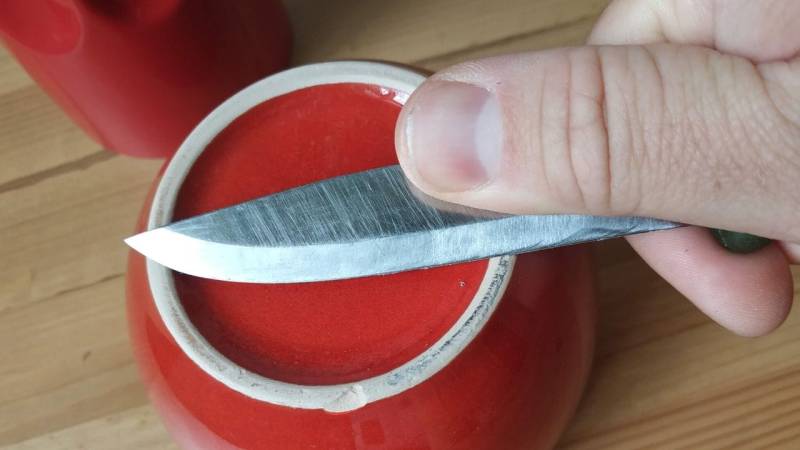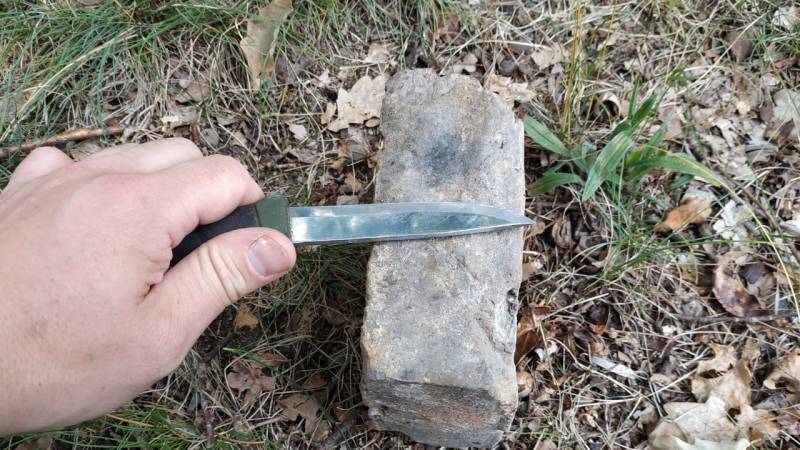
9 Tricks how to sharpen a knife without a sharpening stone
Meine Mutter took the knife and sharpened it along the edge of an old flowerpot.
She did this several times a week, usually when she started cooking.
She told me that it made the knife sharper.
I adopted this method and later sharpened my knives using it.
This is just one method of many to sharpen a knife.
Today, I'm going to show you 9 methods to sharpen your knife using household items – even in the middle of the wilderness.
Basic rules for sharpening
Respect these rules, and you'll surely find other objects to sharpen your knife.
- The object used to sharpen a knife must always be harder than the knife steel.
- Draw the knife forward, with the blade edge first, at an angle of 10 to 20 degrees over the sharpening surface.
- Then, turn the knife over and repeat the sharpening process many times.
Now, let me show you my methods.
1. Sharpening a knife on a flowerpot
A terracotta flowerpot is made of very fine material. Wet the edge of the flowerpot and draw the blade lightly angled over it.
Sharpen your knife for a few minutes, and it will be sharper after a few minutes.

2. Sharpening a knife with ceramic utensils, such as a coffee cup
An old trick of our ancestors and popular for centuries.
Grab a ceramic cup (porcelain works too). This can be a coffee cup, tea cup, or even a bowl or plate.
It's important that the bottom edge is unglazed.
You can sharpen the blade with a moist or dry sharpening stone. Then, draw the knife blade at a slight angle across the stone.
When using water to sharpen the knife, there will be a moist abrasive residue (the sharpening paste) from the stone and blade. Do not wipe off the residue because it can help improve your sharpening results.
With ceramic dishes in your household, you always have a medium-fine sharpening stone available.

3. Using Sandpaper to Sharpen a Knife
I know it sounds a bit strange and some people might think it’s crazy.
But you can use very fine sandpaper to sharpen a knife.
If the knife is dull, use sandpaper with a grit of at least 100-300 to avoid leaving many scratches. If you only want to sharpen the knife, use sandpaper with a grit between 600 and 1000.
To sharpen the knife, lay the sandpaper as flat as possible on a wooden block and draw your knife over it.

4. Using a Nail File to Sharpen a Knife
There are different types of nail files, and the best ones for sharpening knives are those with a very fine grit.
But be careful: only use nail files made of sandpaper. I do not recommend using metal files, since the metal is too soft and won't remove any metal from your knife.
After sharpening with the nail file, please do not put it back in your bathroom. The sandpaper will collect the metal from the knife.

5. Sharpening knives with natural stones
Forgot to sharpen your knife, but you're already in the woods? No problem, there are natural stones.
Find a natural stone – such as river pebbles or slate – and sharpen your knife there. You can find good stones in rivers and streams.
Very flat and wide natural stones are particularly suitable. A fine grain (also known as "fine structure") is especially good.
Moisten the stone and get started, as if you were using a regular sharpening stone.

6. Sharpening knives with a steel rod
Sure, a steel rod can't compare to a honing steel. But a knife can also be sharpened with a steel rod.
The method is easy to apply:
- hold the knife at an angle of 15 to 20 degrees to the steel
- the steel must be guided from the edge to the handle
- it doesn't matter whether you do it quickly or slowly
- then pull the knife over the steel at least ten times

7. Sharpening knives with a file
Metal files are just as suitable as sandpaper. Everything from cut 2 and finer is usable and fine enough to bring a knife back to its sharpness. Coarse files remove too much metal and are not controllable. Do not use them.

8. Using bricks to sharpen a knife
Bricks produce good sharpening results, as I have already tested myself. I was surprised at how well it worked.
Especially when you are out in nature, you can often find a brick in rubble piles.
To sharpen, dampen the brick slightly and grind both sides of the blade at an angle of 10 to 20 degrees.

9. Car window glass
With a car window glass, you can straighten the edge again. The glass is not suitable for removing metal because it is too fine.
Use the top edge, as it is not polished and rougher. Draw your knife several times over the edge of the glass at an angle of 10 to 20 degrees.

Polishing after sharpening
You will think, "Oh, that's sharp" after sharpening. But it can get even better.
Because after sharpening your knives, the blade is still rough and coarse.
To give your knife a finer edge, smooth and polish the blade to remove any unevenness and make it cut even better.
This process is called "honing" and it's pretty quick. Follow these steps:
- Get yourself some material suitable for sharpening: inside a leather belt, leather strip, newspaper, cardboard
- Tighten the material
- Now run the knife over the surface, but with the back of the knife facing forward (so the opposite way to sharpening)
- Repeat the process at least 10 times
Here is a good video on sharpening knives.

These methods do not replace professional sharpening stones
I want to emphasize something to you.
A knife is a tool, and it must be maintained for you to enjoy it for a long time.
All the home remedies listed here for sharpening your knife are only temporary solutions. Most sharpening methods are often not optimal and remove too much material too roughly.
The sharpness of your knife will likely never be as good as when you use a professional sharpening stone.
If you want to sharpen your knife regularly, grab a sharpening stone, honing steel, or a ceramic sharpening rod.

And, did the tips help you? Did you learn a new method?


Author of the guide
Martin Gebhardt
Hey, I'm Martin. On my blog, you will learn the basics and numerous details about living in the wild. I think survival, bushcraft and the good life in nature are the keys to happiness. Find me here on Instagram or on YouTube. You can find more about my mission on the About Me page.
Was this guide helpful?
56 people found this guide helpful.
4.93 out of 5 points (57 Ratings)
Comments (0)
This post may contain affiliate links. So if you click on the links and make a purchase, I will receive a small commission at no additional cost to you. Click here, to learn more about it.


